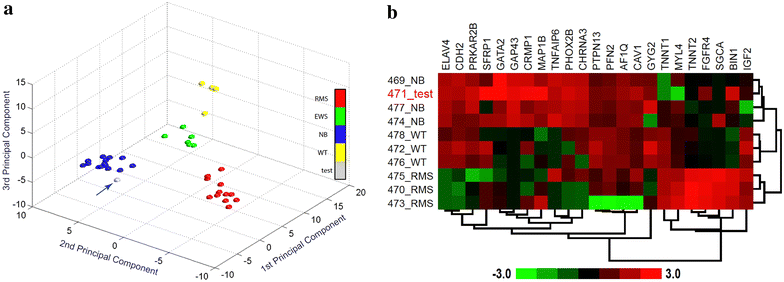Case report: value of gene expression profiling in the diagnosis of atypical neuroblastoma
- PMID: 28818093
- PMCID: PMC5561630
- DOI: 10.1186/s13104-017-2724-4
Case report: value of gene expression profiling in the diagnosis of atypical neuroblastoma
Abstract
Background: Nephroblastoma and neuroblastoma belong to the most common abdominal malignancies in childhood. Similarities in the initial presentation may provide difficulties in distinguishing between these two entities, especially if unusual variations to prevalent patterns of disease manifestation occur. Because of the risk of tumor rupture, European protocols do not require biopsy for diagnosis, which leads to misdiagnosis in some cases.
Case presentation: We report on a 4½-year-old girl with a renal tumor displaying radiological and laboratory characteristics supporting the diagnosis of nephroblastoma. Imaging studies showed tumor extension into the inferior vena cava and bilateral lung metastases while urine catecholamines and MIBG-scintigraphy were negative. Preoperative chemotherapy with vincristine, actinomycine D and adriamycin according to the SIOP2001/GPOH protocol for the treatment of nephroblastoma was initiated and followed by surgical tumor resection. Histopathology revealed an undifferentiated tumor with expression of neuronal markers, suggestive of neuroblastoma. MYCN amplification could not be detected. DNA-microarray analysis was performed using Affymetrix genechip human genome U133 plus 2.0 and artificial neural network analysis. Results were confirmed by multiplex RT-PCR.
Results: Principal component analysis using 84 genes showed that the patient sample was clearly clustering with neuroblastoma tumors. This was confirmed by hierarchical clustering of the multiplex RT-PCR data. The patient underwent treatment for high-risk neuroblastoma comprising chemotherapy including cisplatin, etoposide, vindesine, dacarbacine, ifosfamide, vincristine, adriamycine and autologous stem cell transplantation followed by maintenance therapy with 13-cis retinoic acid (GPOH NB2004 High Risk Trial Protocol) and is in complete long-term remission.
Conclusion: The use of gene expression profiling in an individual patient strongly contributed to clarification in a diagnostic dilemma which finally led to a change of diagnosis from nephroblastoma to neuroblastoma. This case underlines the importance of gene-expression profiling in the correct diagnosis of childhood neoplasms with atypical presentation to ensure that adequate treatment regimens can be applied.
Keywords: Case report; Gene expression profiling; Nephroblastoma; Neuroblastoma.
Figures



References
-
- Bauchinger S, Lackner H, Schwinger W, Sovinz P, Benesch M, Sorantin E, et al. Primary renal neuroblastoma metastasizing into liver and lungs with tumor thrombus extension into the right atrium. Klin Pädiatr. 2014;226(6–7):369–371. - PubMed
Publication types
MeSH terms
Substances
LinkOut - more resources
Full Text Sources
Other Literature Sources
Medical

